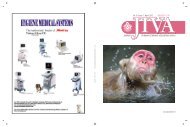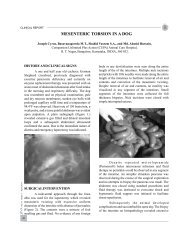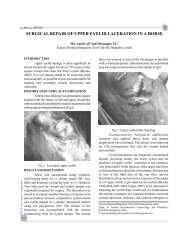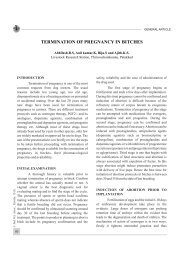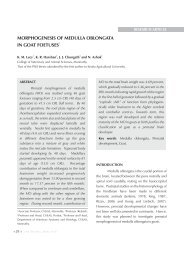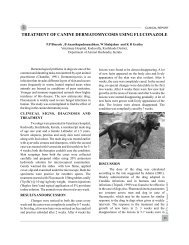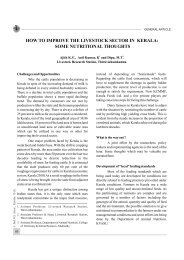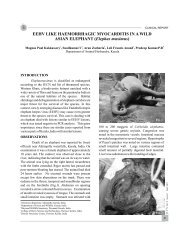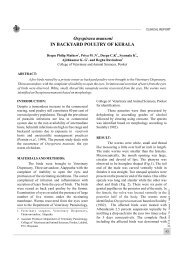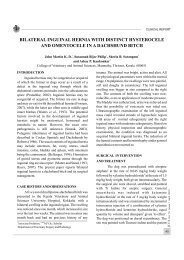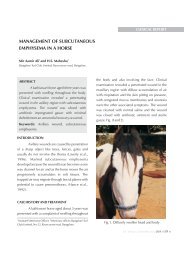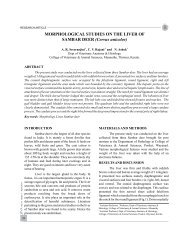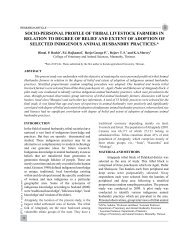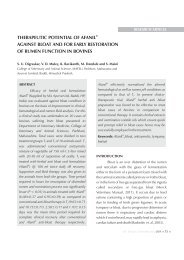obstructive urolithiasis in dogs - Jivaonline.net
obstructive urolithiasis in dogs - Jivaonline.net
obstructive urolithiasis in dogs - Jivaonline.net
Create successful ePaper yourself
Turn your PDF publications into a flip-book with our unique Google optimized e-Paper software.
GENERAL ARTICLE<br />
OBSTRUCTIVE UROLITHIASIS IN DOGS: ADVANCES IN DIAGNOSIS<br />
AND MANAGEMENT<br />
1 2 3 4 5<br />
Sarada Amma .T , Sheeja, V.M. , Rajankutty.K , John Mart<strong>in</strong> K.D and Usha N.Pillai.<br />
Department of Veter<strong>in</strong>ary Surgery and Radiology,<br />
College of Veter<strong>in</strong>ary and Animal Sciences, Mannuthy, Thrissur<br />
Kerala Veter<strong>in</strong>ary and Animal Sciences University<br />
JIVA Vol. 9 Issue 1 April 2011<br />
The ur<strong>in</strong>ary system is designed to dispose off<br />
the metabolic waste products <strong>in</strong> soluble form. Some<br />
of these waste products are spar<strong>in</strong>gly soluble and<br />
occasionally precipitate out of solution to form<br />
crystals. Urolithiasis is such formation of crystals/<br />
calculi from less soluble crystalloids of ur<strong>in</strong>e. Such<br />
crystals/ small concretions formed become lodged<br />
anywhere <strong>in</strong> the ur<strong>in</strong>ary system and may grow to<br />
sufficient size/ accumulate to cause cl<strong>in</strong>ical signs.<br />
INCIDENCE.<br />
Urolithiasis is a very common condition met with<br />
<strong>in</strong> <strong>dogs</strong> and almost all breeds are affected. Majority of<br />
the breeds affected are Labrador Retrievers, German<br />
Shepherd Dogs, Dachshunds, Boxers and<br />
Pomeranians. Even though <strong>in</strong>cidences <strong>in</strong> puppies<br />
were reported most of the <strong>dogs</strong> affected were between<br />
4 to 8 years of age. Male <strong>dogs</strong> are more affected than<br />
females.<br />
Site of occurrence<br />
Calculi may form any where <strong>in</strong> the ur<strong>in</strong>ary<br />
system. In <strong>dogs</strong> lower ur<strong>in</strong>ary tract obstructions are<br />
more common affect<strong>in</strong>g the urethra. Lodg<strong>in</strong>g of the<br />
calculi are most often encountered <strong>in</strong> the groove of os<br />
penis and beh<strong>in</strong>d the level of os penis and at bladder<br />
neck Obstruction due to accumulation of calculi<br />
through out the length of urethra is also observed. .<br />
Nephroliths are calculi formed <strong>in</strong> the kidney, and<br />
ureteroliths <strong>in</strong> the ureter.<br />
Size and shape of calculi varies . Small<br />
crystals to large s<strong>in</strong>gle or multiple calculi are noticed.<br />
Large calculi may rema<strong>in</strong> <strong>in</strong> the bladder with out<br />
caus<strong>in</strong>g any cl<strong>in</strong>ical signs. Small calculi/ gravels <strong>in</strong><br />
the bladder are caus<strong>in</strong>g more cl<strong>in</strong>ical signs as it often<br />
migrate <strong>in</strong>to urethra and gradually accumulate and<br />
lead to partial/complete obstruction to ur<strong>in</strong>e flow.<br />
56<br />
Composition of of calculi<br />
The composition of calculi consisted of<br />
Magnesium ammonium phosphate (Struvite), Calcium<br />
oxalate (Monohydrate, Dihydrate), Calcium hydrogen<br />
phosphate dihydrate (Brushite), carbonate apatite,<br />
Urates, Calcium phosphate (Hydroxy apatite),<br />
Ammonium acid urates, Uric acid, Cyst<strong>in</strong>e, Silica,<br />
Matrix, Mixed types. The most common types of calculi<br />
encountered <strong>in</strong> <strong>dogs</strong> are magnesium ammonium<br />
phosphate, ammonium acid urate, calcium oxalate and<br />
Cyst<strong>in</strong>e. Less common types of calculi encountered <strong>in</strong><br />
<strong>dogs</strong> <strong>in</strong>clude calcium phosphate, silica, sodium acid<br />
urate, carbonate, xanth<strong>in</strong>e<br />
ETIOPATHOGENESIS<br />
Understand<strong>in</strong>g the etiopthognesis of Urolithiasis<br />
is an essential pre-requisite for therapy and prevention<br />
of calculi.<br />
Initiation and growth<br />
The <strong>in</strong>itial step <strong>in</strong> the development of uroliths is<br />
the formation of a crystal nidus. It depends upon the<br />
super saturation of ur<strong>in</strong>e with calculogenic crystalloids<br />
and may be <strong>in</strong>fluenced by magnitude of renal excretion<br />
of the crystalloid, ur<strong>in</strong>e pH and crystallization <strong>in</strong>hibition<br />
<strong>in</strong> ur<strong>in</strong>e. Further growth of the crystal nidus depends on<br />
its ability to rema<strong>in</strong> <strong>in</strong> the ur<strong>in</strong>ary system, the degree and<br />
duration of super saturation of the ur<strong>in</strong>e with<br />
crystalloids, identical or different from that of the nidus.<br />
There are several factors, usually work<strong>in</strong>g <strong>in</strong><br />
comb<strong>in</strong>ation that lead to urolith formation. Inadequate<br />
water <strong>in</strong>take, consumption of hard water, diet rich <strong>in</strong><br />
prote<strong>in</strong>, m<strong>in</strong>erals, <strong>in</strong>fection of the ur<strong>in</strong>ary system,<br />
excess medication lead<strong>in</strong>g to variation <strong>in</strong> ur<strong>in</strong>e pH and<br />
1 2 3<br />
Professor and Head, M.V.Sc Scholar, Professor<br />
4<br />
Associate Professor, Dept.of Surgery and Radiology, CV& AS, Mannuthy<br />
5<br />
Associate professor, Veter<strong>in</strong>ary Cl<strong>in</strong>ical Medic<strong>in</strong>e and Jurisprudence
GENERAL ARTICLE<br />
prolonged use of calcium and other m<strong>in</strong>eral supplements<br />
etc. are the major causes.<br />
Ur<strong>in</strong>ary tract <strong>in</strong>fections.<br />
Streptococcus, Staphylococci and proteus and<br />
E.coli species are common micro organisms<br />
encountered. Staphylococci and proteus species are<br />
potent urease producer hence they are commonly<br />
associated with struvite urolith <strong>in</strong> <strong>dogs</strong>. Staphylococci<br />
also produce phosphatase <strong>in</strong> addition to urease. Bacterial<br />
phosphatase might <strong>in</strong>crease the concentrations of<br />
<strong>in</strong>organic phosphorus by action on organic phosphates.<br />
The solubility of struvite decreases <strong>in</strong> alkal<strong>in</strong>e<br />
ur<strong>in</strong>e. Conversion of urea to ammonia as a result of<br />
bacterial urease appears to be important <strong>in</strong> caus<strong>in</strong>g ur<strong>in</strong>e<br />
to become super saturated with magnesium ammonium<br />
phosphate as well as calcium phosphate and carbonate<br />
apatite crystals. Urease produced by bacteria <strong>in</strong>creases<br />
alkalisation of ur<strong>in</strong>e and favours formation of ammonia<br />
and carbon dioxide and subsequently carbonate apatite<br />
crystals. Both urea and urease are required for<br />
alkalisation, super saturation and subsequent<br />
precipitation of struvite (Magnesium ammonium<br />
phosphate hexahydrate) crystals.<br />
Ur<strong>in</strong>e pH.<br />
Normally <strong>dogs</strong> and cats have an acidic ur<strong>in</strong>e.<br />
Renal tubular acidosis, consumption of diet that reduces<br />
production of acid catabiolite and/or prolongation of the<br />
post prandial alkal<strong>in</strong>e tide lead<strong>in</strong>g to a persistant<br />
<strong>in</strong>crease <strong>in</strong> ur<strong>in</strong>e pH.<br />
Ge<strong>net</strong>ic<br />
The high <strong>in</strong>cidence of struvite urolith <strong>in</strong> some<br />
breeds of <strong>dogs</strong> such as m<strong>in</strong>iature schnauzers suggests a<br />
familiar tendency.<br />
Disease<br />
One of the many consequences of this disease<br />
called Porto-systemic shunts (PSS) is the formation of<br />
ammonium urate bladder stones.<br />
Medications<br />
Medications that <strong>in</strong>crease or decrease the pH of the<br />
ur<strong>in</strong>e can also set the stage for stone formation. Some<br />
medications can cause formation of stones when used<br />
for a along period. Sometimes by <strong>in</strong>creas<strong>in</strong>g the<br />
calcium level <strong>in</strong> the ur<strong>in</strong>e.<br />
M<strong>in</strong>eral crystals<br />
Ur<strong>in</strong>e that is saturated with excess amount of<br />
certa<strong>in</strong> m<strong>in</strong>erals are prone to form bladder stones.<br />
These m<strong>in</strong>erals commonly <strong>in</strong>clude magnesium,<br />
phosphorus, calcium and ammonia. Most stones<br />
consist of an organic matrix of prote<strong>in</strong> surrounded by<br />
crystall<strong>in</strong>e m<strong>in</strong>erals.<br />
CLINICAL SYMPTOMS<br />
Typical symptoms <strong>in</strong>clude dribbl<strong>in</strong>g of ur<strong>in</strong>e,<br />
stra<strong>in</strong><strong>in</strong>g to ur<strong>in</strong>ate (stranguria), blood <strong>in</strong> the ur<strong>in</strong>e<br />
(hematuria), ur<strong>in</strong>at<strong>in</strong>g small amounts frequently<br />
(pollakiuria)and distension of ur<strong>in</strong>ary bladder. In<br />
cystolithiasis there may be polyuria.. Some pets can<br />
have bladder stones without any apparent symptoms<br />
at all. Soil<strong>in</strong>g of the per<strong>in</strong>eal region due to frequent<br />
ur<strong>in</strong>ation is the typical symptom <strong>in</strong> female <strong>dogs</strong>.<br />
Bladder distension is not seen unless urethra is<br />
obstructed. The calculi <strong>in</strong> the bladder can be<br />
palpated. Distension of bladder on palpation is the<br />
apparent sign <strong>in</strong> complete obstruction of the urethra.<br />
DIAGNOSIS<br />
Based on the history and cl<strong>in</strong>ical symptoms.<br />
Radiography and ultrasound scann<strong>in</strong>g are used for<br />
confirmation to locate the site of occurrence of<br />
uroliths. Most of the bladder stones are palpable.<br />
Ur<strong>in</strong>e analysis and Ur<strong>in</strong>e culture reveals the presence<br />
of calculi and <strong>in</strong>fection if any. Qualitative analysis<br />
provides the most def<strong>in</strong>ite diagnosis, prognostic and<br />
therapeutic <strong>in</strong>formation.<br />
Ur<strong>in</strong>alysis.<br />
A ur<strong>in</strong>e analysis is crucial <strong>in</strong> mak<strong>in</strong>g a correct<br />
diagnosis. The pH of the ur<strong>in</strong>e and the presence of<br />
blood, pus cells bacteria, crystals and prote<strong>in</strong> provide<br />
valuable <strong>in</strong>formation.<br />
Ur<strong>in</strong>e culture and sensitivity test:<br />
Cultur<strong>in</strong>g the ur<strong>in</strong>e will reveal the type of<br />
<strong>in</strong>fection <strong>in</strong>volved, and to select effective antibiotics.<br />
Qualitative analysis: Chemical analysis of ur<strong>in</strong>e<br />
sample and calculi .<br />
Quantitative analysis<br />
In contrast to chemical methods of analysis<br />
physical methods have been proven to be for superior<br />
JIVA Vol. 9 Issue 1 April 2011<br />
57
GENERAL ARTICLE<br />
JIVA Vol. 9 Issue 1 April 2011<br />
<strong>in</strong> the identification of crystall<strong>in</strong>e substances.<br />
Physical methods commonly used by lab <strong>in</strong>clude<br />
comb<strong>in</strong>ation of polariz<strong>in</strong>g light microscopy, X-ray<br />
diffractrometry and IR spectroscopy.<br />
THERAPY<br />
Therapy of Urolithiasis encompases the relief<br />
of obstruction by cystocentesis, elim<strong>in</strong>ation of<br />
exist<strong>in</strong>g calculi by medical/surgical means,<br />
eradication or control of ur<strong>in</strong>ary tract <strong>in</strong>fection and<br />
prevention of recurrence of urolith and treatment for<br />
concurrent diseases.<br />
Medical dissolution of calculi<br />
The objectives of medical management of<br />
uroliths are to arrest further urolith growth and to<br />
promote urolith dissolution by correct<strong>in</strong>g or<br />
controll<strong>in</strong>g underly<strong>in</strong>g abnormalities for therapy to<br />
be effective. Useful <strong>in</strong> partial obstruction and to<br />
prevent recurrence.<br />
1.Increas<strong>in</strong>g the volume of ur<strong>in</strong>e <strong>in</strong> which<br />
crystalloids are dissolved or suspended to<br />
elim<strong>in</strong>ate along with ur<strong>in</strong>e<br />
2. Induc<strong>in</strong>g under saturation of ur<strong>in</strong>e by <strong>in</strong>creas<strong>in</strong>g<br />
the solubility of crystalloids <strong>in</strong> ur<strong>in</strong>e.<br />
(Adm<strong>in</strong>istration of medication and to change ur<strong>in</strong>e<br />
pH to create an environment less favourable for<br />
crystallization.)<br />
3. Reduc<strong>in</strong>g the quantity of calculogenic crystalloids<br />
<strong>in</strong> ur<strong>in</strong>e. It <strong>in</strong>cludes changes <strong>in</strong> diet, adm<strong>in</strong>istration<br />
of allopur<strong>in</strong>ol to decrease the amount of uric acid<br />
formed, and adm<strong>in</strong>istration of cellulose phosphate<br />
to m<strong>in</strong>imize <strong>in</strong>test<strong>in</strong>al absorption of calcium.<br />
4.Medication to <strong>in</strong>hibit urease production by micro<br />
organisms. Acetohydroxamic acid<br />
(AHA)@25mg/kg <strong>in</strong> divided doses was found<br />
effective for struvite calculi.<br />
5.Use of hydrochlorothiazide @ 4-8 mg/kg <strong>in</strong><br />
divided doses are found effective <strong>in</strong> reduc<strong>in</strong>g<br />
calcium excretion and used <strong>in</strong> calcium oxalate.<br />
6. Allopur<strong>in</strong>ol at a dose rate of 30 mg/kg for one<br />
month and later at dose rate of 10mg/kg for next<br />
month for urate stones.<br />
7. Dissolution of calculi (Struvite) <strong>in</strong> the urethra and<br />
bladder with calculolytic buffer solution<br />
58<br />
(Walpole's solution) by <strong>in</strong>fus<strong>in</strong>g through the catheter<br />
<strong>in</strong>serted close to the obstruct<strong>in</strong>g calculi has been<br />
reported. Repeated attempts are required.<br />
SURGICAL TREATMENT<br />
In complete obstruction of urethra<br />
decompression of the bladder is an emergency by<br />
cystocentesis, urethrotomy / cystotomy. Removal of<br />
obstruct<strong>in</strong>g calculi accord<strong>in</strong>g to the region affected are<br />
to be carried out. The site and technique depends upon<br />
the location of the block and the condition of the patient.<br />
Usually <strong>dogs</strong> are presented with urethral blockage and<br />
treatment consisted of urethrotomy and or cystotomy.<br />
For calculi <strong>in</strong> kidney nephrotomy, pyelolithotomy,<br />
lithotrypsy, US fragmentation (lithotrity) are<br />
employed.<br />
Prevention of recurrent Urolithiasis<br />
Calculi of all types have a tendency to recur<br />
follow<strong>in</strong>g their surgical removal or medical dissolution.<br />
Recurrence may be related to (1) Persistence of<br />
underly<strong>in</strong>g causes of Urolithiasis (.2) Failure to remove<br />
all uroliths from ur<strong>in</strong>ary tract especially small caluli (3)<br />
Persistence of UTI with urease produc<strong>in</strong>g<br />
bacteria.(4)Lack of owner or patient compliance with<br />
therapeutic or prophylactic recommendations .<br />
(5)Prolonged use of medications.<br />
Management <strong>in</strong>cludes:<br />
1.Increas<strong>in</strong>g ur<strong>in</strong>e volume: Provide adequate fluid<br />
<strong>in</strong>take. Adm<strong>in</strong>istration of diuretics. The primary<br />
reason for the use of the diuretic is that, it dilutes the<br />
ur<strong>in</strong>e, and flush out the tract and decreases the ur<strong>in</strong>ary<br />
excretion of calcium. However it also <strong>in</strong>creases the<br />
ur<strong>in</strong>ary excretion of magnesium.<br />
2.The eradication or control of <strong>in</strong>fection of the ur<strong>in</strong>ary<br />
tract caused by urease produc<strong>in</strong>g bacteria is the most<br />
important factor for prevent<strong>in</strong>g the recurrence of most<br />
<strong>in</strong>fection. If recurrent UTI persists <strong>in</strong> def<strong>in</strong>ite therapy<br />
with prophylactic doses of antimicrobial agents that<br />
are elim<strong>in</strong>ated <strong>in</strong> ur<strong>in</strong>e <strong>in</strong> high concentration is<br />
<strong>in</strong>dicated. These agents <strong>in</strong>clude flouroqu<strong>in</strong>olone,<br />
nitrofuranto<strong>in</strong>, ampicill<strong>in</strong>, and nalidixic acid and<br />
chloramphenicol. Ma<strong>in</strong>ta<strong>in</strong> ur<strong>in</strong>e pH.<br />
3 .Supplementary therapy with potassium citrate will be<br />
of useful <strong>in</strong> calcium oxalate Urolithiasis.
GENERAL ARTICLE<br />
4. Diet management. Reduce prote<strong>in</strong> content, leafy<br />
vegetables, tomato etc <strong>in</strong> the feed.<br />
CONCLUSION<br />
Urolithiasis is frequently met with <strong>in</strong> can<strong>in</strong>e<br />
patients. Animals are presented with history of oliguria,<br />
difficulty <strong>in</strong> ur<strong>in</strong>ation or haematuria. Diagnosis is made<br />
by observ<strong>in</strong>g cl<strong>in</strong>ical symptoms and is confirmed by<br />
radiography/Ultrasound scann<strong>in</strong>g.<br />
Treatment is successful if attended <strong>in</strong> early stage<br />
itself. Surgical treatment is more effective. It <strong>in</strong>cludes<br />
decompression of the bladder by cystocentesis,<br />
urethrotomy cystotomy, lithotrity accord<strong>in</strong>g to the<br />
location of obstruction and removal of calculi.<br />
Medical treatment <strong>in</strong>cludes adequate fluid<br />
adm<strong>in</strong>istration for dilution and elim<strong>in</strong>ation of crystals,<br />
use of calculolytic drugs, alter<strong>in</strong>g pH of ur<strong>in</strong>e, alter<strong>in</strong>g<br />
diet, if necessary and suitable antibiotics to prevent<br />
urease production and <strong>in</strong>fection are useful <strong>in</strong><br />
<strong>in</strong>complete block but requires long-term medication to<br />
prevent recurrence also.<br />
Recurrence can be prevented by diuretics, suitable<br />
antibiotics, alter<strong>in</strong>g pH of ur<strong>in</strong>e and diet management<br />
REFERENCES<br />
Abdullahi,S.U and Adeyanju, J.B.(1987).Medical<br />
dissolution of ammonium urate uroliths <strong>in</strong> a dog.<br />
Mod. Vet. Pract.20: 438<br />
Damodaran, R (2004).Evaluation and Management of<br />
Urolithiasis <strong>in</strong> Dogs. M.V.Sc. Thesis submitted to<br />
Kerala Agricultural University, Vellanikkara,<br />
Thrissur.p.99<br />
Dowl<strong>in</strong>g, M.P.(1996). Anti microbial therapy of ur<strong>in</strong>ary<br />
tract <strong>in</strong>fections.Can.Vet.J.37:438-441.<br />
Gourley, I.M.,Vasseur P.B.,(1998).,General Small<br />
Animal Surgery ., J .B Lipp<strong>in</strong>cott Company.,<br />
Philadelphia .,574 - 612.<br />
Hoff, M.E.(1986).Dietary management of struvite<br />
cystic calculi <strong>in</strong> a dog. Mod. Vet. Pract. 90:<br />
883 - 886<br />
L<strong>in</strong>g, G.V. ,Franti, C.E., Ruby, A.L and<br />
Johnson,D.L(1998) Urolithiasis <strong>in</strong> <strong>dogs</strong> II<br />
Breed prevalence and <strong>in</strong>terrelations of breed ,<br />
sex, age and m<strong>in</strong>eral composition<br />
.Am.J.Vet.Res .59(5):624 629<br />
Janke, J.J.,Osterstock, J.B.,Wasburn ,K.E.Bissett,<br />
W.T.Russel Jr. A.J and Hooper,<br />
R.N.(2009).Use of Walpole's solution for<br />
treatment of goats with Urolithiasis.<br />
J.Am.Vet.Med.Assoc.234: 249-252<br />
L<strong>in</strong>g,G.V.,Franti ,C.E Johnson, D.L and Ruby, A.L<br />
(1998).Urolithiasis <strong>in</strong> Dogs. III: Prevalence<br />
of ur<strong>in</strong>ary tract <strong>in</strong>fection, age,sex and m<strong>in</strong>eral<br />
composition. Am. J. Vet .Res.59: 650-660<br />
Markwell,P.J. and Stevenson,A.E.(2000).Nutritional<br />
management of can<strong>in</strong>e Urolithiasis. Advances<br />
<strong>in</strong> cl<strong>in</strong>ical nutrition Waltham<br />
Focus.Spl.Ed.43-47.<br />
Shaw,D.H(1990) A systematic approach to<br />
manag<strong>in</strong>g lower ur<strong>in</strong>ary tract <strong>in</strong>fections. Vet.<br />
Med. 91:379 -386<br />
Sheeja,V.M.(2008) Radiographic evaluation and<br />
management of lower ur<strong>in</strong>ary tract disorders<br />
<strong>in</strong> <strong>dogs</strong>. M.V.Sc.Thesis submitted to Kerala<br />
Agricultural University, Vellanikkara,<br />
Thrissur.p.130<br />
Voros,K., Wladar,S .,Varbley, Tand Fenyes<br />
B.(1993). Ultrasonographic diagnosis of<br />
ur<strong>in</strong>ary bladder calculi <strong>in</strong> <strong>dogs</strong>. Can<strong>in</strong>e Pract.<br />
18 :29-33<br />
JIVA Vol. 9 Issue 1 April 2011<br />
59



